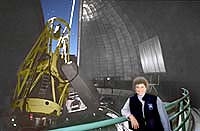Lab astrophysicist Claire Max wins prestigiousE.O. Lawrence Award
LIVERMORE, Calif. - Claire Max, a longtime astrophysicist at Lawrence Livermore National Laboratory and a faculty member at UC Santa Cruz, is one of seven winners of the Department of Energy's prestigious E.O. Lawrence Awards for 2004. The award is given in seven categories for outstanding contributions in the broadly defined field of atomic energy.
Max will receive the award in the physics category, for her contributions to the theory of laser guide star adaptive optics and its application in ground-based astronomy to correct telescopic images for the blurring caused by light passing through the atmosphere. Max is a member of the Lab's Institute for Geophysics and Planetary Physics and was its founding director back in the early 1980s. She currently divides her time between the institute and UC Santa Cruz, where she is a professor and deputy director for the Center for Adaptive Optics.
"We are all enriched by the contributions these researchers have made, ranging from engines with no moving parts to better ways to see the stars," Secretary of Energy Spencer Abraham said of this years winners, six of whom are affiliated with the University of California. Three winners come from Los Alamos National Laboratory and one from Lawrence Berkeley National Laboratory. UC manages all three laboratories for the Department of Energy.
"These awards, and the research for which they are given, show that DOE could easily be called the Department of Science and Energy," Abraham said.
Awardees are chosen for their work in one of seven categories: chemistry, national security, nuclear technology, physics, life science, materials research and environmental science and technology. Winners receive a gold medal, a citation and $50,000. The awards will be presented in a ceremony in Washington, DC on Nov. 8.
Max is the 25th recipient from the Laboratory since the awards were established in 1959, in memory of Laboratory co-founder and namesake Ernest Orlando Lawrence.
"Claire is an exemplary, internationally recognized scientist and I extend my sincere congratulations to her," said Laboratory Director Michael R. Anastasio. "This recognition from DOE appropriately spotlights Claire's accomplishments in plasma physics and astrophysics and provides us all the opportunity to join in celebrating with her these achievements and accolades."
"I cannot believe how good this makes me feel," said Max. "It is quite a thrill to receive this award."
Throughout her career, Max has made important contributions to the separate fields of plasma physics and astrophysics, and she is considered a central figure in the field of adaptive optics (AO) for ground-based telescopes. Her work on laser guide stars, which are used with adaptive optics to correct the blurring of telescopic imagery caused by turbulence in the atmosphere, has resulted in an ongoing revolution in ground-based astronomy.
Max is one of the co-inventors of the sodium laser guide star, and she is a leader in implementing these new artificial guide stars at astronomical observatories. Max recalls her team's early days of research and experimentation on laser guide stars at the Livermore site, and how "the notion of pointing a 1000 watt laser into the sky to measure turbulence seemed a bit absurd. Even we thought we were a little zany."
But use of laser guide stars went on to bear "important fruit, including infrared images and spectra of storms on Neptune, hydrocarbon oceans and ice continents on Titan, and black holes in the core of our own Milky Way and in the center of nearby galaxies," Max said.
Max led a group that built the AO system and sodium laser guide star for Lick Observatory on Mt. Hamilton., and designed the laser beacon and AO system for the W. M. Keck Observatory in Hawaii, in a collaboration with Keck Observatory staff.
Though laser guide star adaptive optics on ground-based telescopes is still in its infancy, "the expanded science that can be done with such modified telescopes is extraordinary," Max said. "The clarity of ground-based observations is enhanced by a factor of 50 or more so that it becomes comparable with space telescopes, but with all the advantages of the larger telescope size that is possible from being on the ground."
Max joined the Laboratory in 1974 as part of a new group formed to understand the plasma physics of laser fusion. In the early 1980s, Max's career branched out widely. She became the founding director of the Institute of Geophysics and Planetary Physics, a position she held for nearly a decade. She also became the first female member of the elite JASON group of scientific advisers to the Department of Defense.
Max joins a list of Lawrence winners that includes former Lab directors Michael May, John Foster, Herb York and John Nuckolls.
Other recipients of this year's awards include Bette Korber (life sciences), Fred Mortensen (national security) and Gregory Swift (environmental science and technology) of Los Alamos National Laboratory; Richard Saykally (chemistry) of Lawrence Berkeley and UC Berkeley; Ivan Schuller (materials research), UC San Diego; and Nathaniel Fisch (nuclear technology), Princeton Plasma Physics Laboratory.>
Founded in 1952, Lawrence Livermore National Laboratory is a nuclear security laboratory, with a mission to ensure national security and apply science and technology to the important issues of our time. Lawrence Livermore National Laboratory is managed by the University of California for the National Nuclear Security Administration/Department of Energy.
Contact
Lynda Seaver[email protected]
925-423-3103






